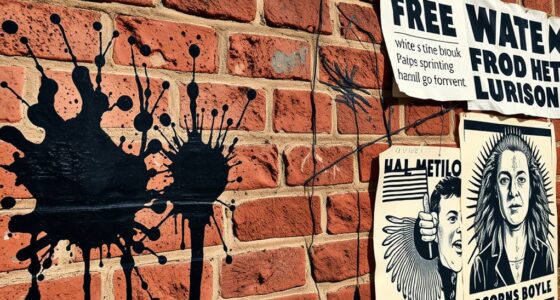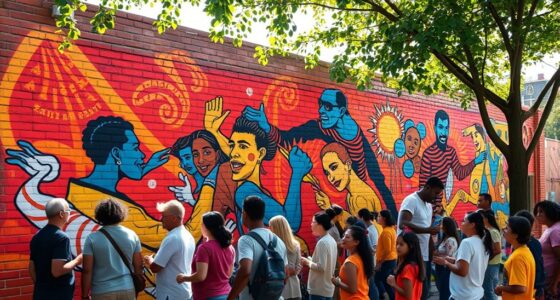Artists confront inequality by creating powerful visual statements that challenge societal norms and spotlight injustices. They transform public spaces with murals, installations, and provocative imagery to demand attention and spark conversations. By engaging viewers emotionally and encouraging reflection, these works elevate marginalized voices and push for societal change. Visual activism turns art into a rallying cry for justice, making it impossible to ignore. Explore how these creative efforts continue to shape cultures and challenge perceptions.
Key Takeaways
- Artists use provocative visual imagery in murals and installations to highlight social injustices and demand societal change.
- Visual activism transforms public spaces into platforms for protesting racism and amplifying marginalized voices.
- Artwork evokes emotional responses that foster empathy, awareness, and motivate viewers to challenge systemic inequality.
- Artists confront societal norms and stereotypes through creative expressions that question and dismantle racism.
- Art redefines cultural narratives by promoting accurate, respectful representation of marginalized communities and inspiring social transformation.

Have you ever wondered how art can challenge racism and promote social change? It’s a powerful question because art isn’t just about aesthetics; it’s a tool for activism and a mirror reflecting society’s deepest issues. When you look at visual activism, you see how artists harness their creativity to spotlight inequality, spark conversations, and inspire action. By creating provocative images, murals, or installations, artists demand attention to social injustices that often go unnoticed or ignored. Visual activism makes these issues impossible to overlook, forcing viewers to confront uncomfortable truths. It transforms public spaces into platforms for protest, turning walls, streets, and galleries into battlegrounds for social justice. These visual statements serve as rallying cries, uniting communities and amplifying marginalized voices. Through this form of activism, artists challenge the dominant narratives that perpetuate racism and inequality, insisting that cultural representation must be inclusive and honest. They use their work to showcase diverse stories, breaking down stereotypes and broadening the understanding of different cultures and identities. The impact of such art is amplified when it employs color and contrast effectively to evoke emotional responses and highlight social issues.
Your role as a viewer becomes integral when engaging with this kind of art. You’re invited not just to observe but to reflect and act. When you see a mural depicting racial resilience or a sculpture embodying cultural pride, recognize the intention behind it. These works aim to elevate underrepresented voices, ensuring that cultural representation isn’t just tokenism but a genuine acknowledgment of diverse experiences. The power of visual activism lies in its immediacy—an image can evoke empathy faster than words, stirring emotional responses that motivate change. As more artists choose to confront racism through their work, they create a visual dialogue that challenges societal norms and pushes for a more just future. This type of art demands that you think critically about your own perceptions and biases, fostering a deeper understanding of systemic inequality.
In the end, art against racism isn’t just about creating beautiful images; it’s about using visual activism to redefine cultural narratives. It’s about ensuring that cultural representation accurately and respectfully reflects the realities of marginalized communities. By engaging with these works, you help sustain a movement that refuses to stay silent in the face of injustice. Art becomes a catalyst, transforming society one powerful image at a time, and reminding us that change begins with seeing the world through different eyes.
Frequently Asked Questions
How Do Artists Select Their Themes to Address Racism Effectively?
You select themes to address racism effectively by using powerful visual symbolism that resonates deeply and communicates complex ideas clearly. You consider your audience’s perspectives and experiences, aiming to foster engagement and reflection. By choosing relatable or provocative symbols, you spark conversations and emotional responses. This strategic approach guarantees your art not only highlights inequality but also encourages viewers to confront their own biases and support social change.
What Impact Does Art Have on Changing Public Attitudes About Race?
Think of art as a mirror reflecting society’s soul; it can shift your visual perception and evoke powerful emotional responses. When you engage with these works, you may see injustices in new light, fostering empathy and understanding. This emotional connection can challenge stereotypes, slowly changing your attitudes about race. Art’s impact lies in its ability to make the invisible visible, inspiring you to question biases and embrace equality.
Are There Specific Art Forms More Powerful in Confronting Racism?
You find that visual storytelling and performance art are especially powerful in confronting racism. Visual storytelling captures emotions and personal stories, making complex issues relatable and impactful. Performance art actively engages audiences, challenging perceptions through live interactions and expressive actions. These art forms create visceral experiences that can break down stereotypes, foster empathy, and inspire change, making them more effective tools for confronting and addressing racial inequality directly and emotionally.
How Do Artists Collaborate Across Cultures to Fight Racial Inequality?
Think of cultural exchange as a bridge you walk with artists from different backgrounds. You can collaborate on projects that highlight shared struggles and celebrate diversity, breaking down racial barriers. By actively engaging in collaborative projects, you amplify voices that challenge inequality and foster mutual understanding. Your teamwork creates powerful art that speaks across borders, making a real impact in the fight against racial injustice worldwide.
What Challenges Do Artists Face When Addressing Sensitive Racial Issues?
You face censorship challenges and uncertain audience reception when addressing sensitive racial issues. Authorities or institutions might restrict your work, fearing controversy or backlash. You may also struggle to gauge how different communities will respond, risking alienation or misinterpretation. Despite these obstacles, your courage to confront uncomfortable truths can spark essential conversations and promote understanding, making your artwork a powerful tool against racial inequality.
Conclusion
So, next time you walk past a mural or glance at a provocative sculpture, remember—art’s not just decoration; it’s a riotous parade against ignorance. It’s the paint-splattered protest sign, the cheeky billboard shouting, “You can’t silence us!” Because in this colorful battlefield, artists wield brushes like swords, turning blank walls into vivid battlegrounds where inequality gets painted over—one satirical stroke at a time. Who knew activism could be so boldly brush-stroked?









